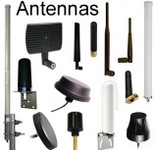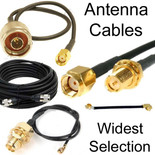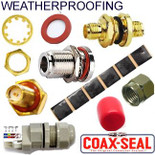Antennas, Antenna Cables, Wireless Products: Technical Articles
Directional Antennas: Longer Range / High Gain by narrowing the beam
Directional Antennas
Directional Antennas provide much better link quality than omni-directional antennas, which have a 360-degree pattern. Antennas for long-range point-to-point and point to multipoint links are always directional rather than omni-directional.

- Directional Antennas boost link quality by concentrating the antenna's signal strength (radiation pattern) in the direction of signal traffic, and reducing interference from unwanted signals.
- Use only when the signal is coming from or transmitted to a particular direction (not when the signal direction is constantly changing, such as when in a boat or a car, unless you can adjust the antenna easily).
- Directional help to avoid multipath interference (which is caused by signal reflection on metal surfaces): Very important in RVs & mobile homes, to aim directly at signal source.
- Client antenna: When you are aiming for a particular Access Point (AP), aim the directional antenna toward it.
- Access Point (AP) antenna: If your AP is sending the signal in a particular direction, use a directional antenna & aim it toward the client(s)
Sectoral antennas such as panel antennas are best in two cases:
- If the signal traffic is going generally directionally (back and forth); and
- When cosmetic appeal is important: Most can be mounted flat on a wall, so that they blend in, cosmetically.
Panel antennas direct the signal in front of the antenna, with a beam-width of approximately 120 degrees horizontally.
Yagi Antennas are not as powerful as parabolic grid antennas (below) but have these advantages:
- Cosmetically much more appealing
- Easier to install and lighter and easier to transport and ship
- Because not as precise as grid antennas, easier to "find your target" signal
- Constructed for heavy duty all weather outdoor usage.
- Parabolic grid or dish antennas are far more directional than Yagi antennas.
Parabolic Grid or Dish Antennas: Longest-range antenna type:
- Focus the power to a central point and beam the Wi-Fi device’s signal to a very specific area.
- Perfect antenna to send your signal a very long distance.
- As the gain of an antenna increases, the antenna’s radiation pattern becomes narrower and so the antenna must be aimed precisely.
- Dish antennas are often used for a point to point system for long haul systems.
For Point to Point Links: Grid parabolic or solid dish antennas enjoy considerable advantages over Yagi antennas because the parabolic antennas compensate antenna length with their width. Yagi antennas of high gain are about 1 meter in length and so installing such a long antenna will be difficult and the antenna may be an eyesore. But a grid antenna of the same dBi can be compact enough to fit in a tight spot and can be secured without any brackets, support arms or guidewires. Their parabolic reflectors enable a high front to back ratio that provides fast speeds by diminishing co-channel interference. Grid parabolic antennas are considered the best for long distance point to point WiFi, due to the ability of the antenna to produce a narrow beam of signals that remain unaffected by interference from any neighboring equipment. The dimensions of the beam of signal are extremely narrow at 16 degrees horizontal and 21 degrees vertical. With such a narrow beam it is possible to achieve the furthest possible WiFi range between two points.
Grid parabolic antennas have much better signal strength than a Yagi antenna with the same gain, and at only half the size of the Yagi antenna.
Parabolic antennas are the most efficient type of directional antennas because they have small side lobes, sharp radiation angles, and a large front-back ratio. They can serve as a primary mirror for all the frequencies of WiFi signal with a small irradiation loss.
Key Technical Details of Directional Antennas
Direction is the pattern formed by the transmitted signal. The increase in gain of a directional antenna, leads to a decrease in the angle of radiation. This allows for a greater distance to be covered while reducing the coverage angle of the transmission. We measure the radiation patterns or the area of coverage in degrees. This angle is also known as a beamwidth.
An antenna does not add any power to the transmitted signal but only redirects the received energy from the transmitter. Redirecting the energy has the consequence of supplying more energy in a particular direction than others.
Beamwidth of a directional antenna is the separation angle between half power points in a radiated pattern of an antenna. This implies that there are only two beamwidths for a directional antenna: vertical beamwidth and horizontal beamwidth.
Front to Back Ratio of a Directional Antenna
Front to back ratio is the measure of directivity of a directional antenna. It is a ratio between the energy directed in a single direction, which is dependent on the radiation pattern to the wasted energy by the antenna. When you increase the gain of a directional antenna, you shall also be increasing the front to back ratio. The best front to back ratio of a directional antenna is normally 20dB.
Indoor Effects on Directional Antennas
Refraction, reflection or diffraction in an environment affects the propagation of any wireless signal. Radio frequency waves take multiple directions between the receiver and the transmitter. Indoor transmission of radio frequency signals differ from outdoor transmission due to the presence of floors, ceilings and other obstructions that contribute towards the attenuation of signals.
Building materials also affect Indoor transmission of signals by directional antennas. The density of building materials has an effect of reducing the propagation speeds of RF signals. RF signals with shorter wavelengths get distorted and absorbed more as compared to signals of higher wavelengths.
The actual effects of antennas installed inside a room should be tested at the actual site.
Mounting and Connections
Directional antennas often require precise aiming for optimal performance. Additionally, they may use specialized antenna connectors (like SMA, RP-SMA, or U.FL) to connect to devices. If you're considering a directional antenna, ensure compatibility with your device's connector type.
Pros and cons of Directional Antennas
The use of directional antennas allows you to divert radio frequency signal energy in a single direction in order to increase the transmission distances. An increase in transmission distance reduces the beamwidth of the signal. You cannot cover bigger areas around the access point as the angular coverage is small Mounting of directional antennas is at times hard due to the fact that you have to find a particular direction where signal strength is high.
Interference
Interference in directional antennas may come from cordless phones, microwave ovens and radar signals from airports. Interference causes the antenna signals to sway at particular frequencies. This variation is known as fading. Fading varies with the frequency of the signal. Interference also increases the SNR of a signal. Antenna gain helps in the improving of SNR and interference to noise ratio.








